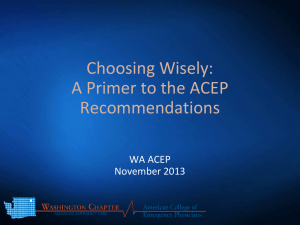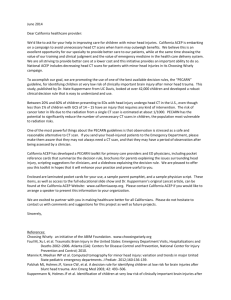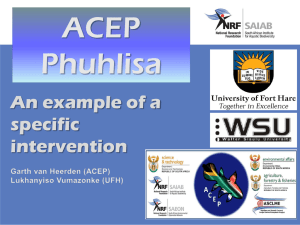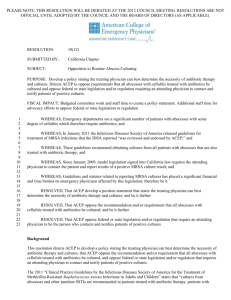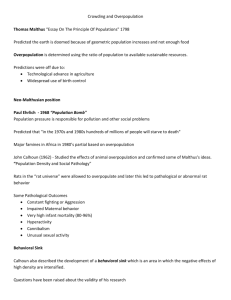ER is for Emergencies
advertisement
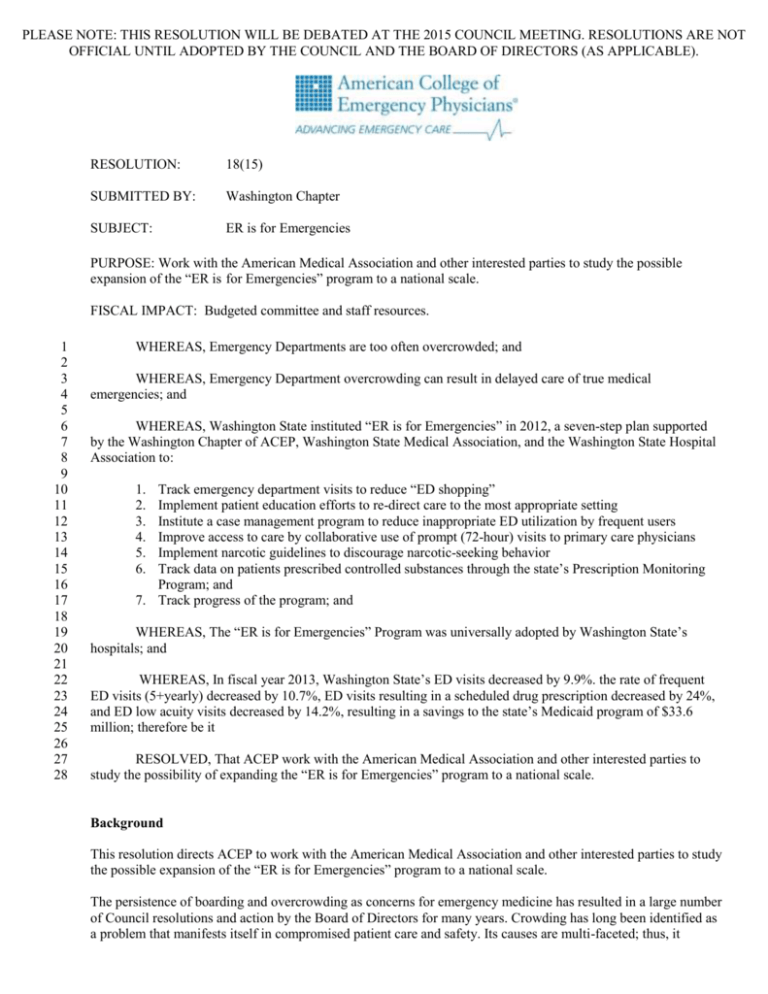
PLEASE NOTE: THIS RESOLUTION WILL BE DEBATED AT THE 2015 COUNCIL MEETING. RESOLUTIONS ARE NOT OFFICIAL UNTIL ADOPTED BY THE COUNCIL AND THE BOARD OF DIRECTORS (AS APPLICABLE). RESOLUTION: 18(15) SUBMITTED BY: Washington Chapter SUBJECT: ER is for Emergencies PURPOSE: Work with the American Medical Association and other interested parties to study the possible expansion of the “ER is for Emergencies” program to a national scale. FISCAL IMPACT: Budgeted committee and staff resources. 1 2 3 4 5 6 7 8 9 10 11 12 13 14 15 16 17 18 19 20 21 22 23 24 25 26 27 28 WHEREAS, Emergency Departments are too often overcrowded; and WHEREAS, Emergency Department overcrowding can result in delayed care of true medical emergencies; and WHEREAS, Washington State instituted “ER is for Emergencies” in 2012, a seven-step plan supported by the Washington Chapter of ACEP, Washington State Medical Association, and the Washington State Hospital Association to: Track emergency department visits to reduce “ED shopping” Implement patient education efforts to re-direct care to the most appropriate setting Institute a case management program to reduce inappropriate ED utilization by frequent users Improve access to care by collaborative use of prompt (72-hour) visits to primary care physicians Implement narcotic guidelines to discourage narcotic-seeking behavior Track data on patients prescribed controlled substances through the state’s Prescription Monitoring Program; and 7. Track progress of the program; and 1. 2. 3. 4. 5. 6. WHEREAS, The “ER is for Emergencies” Program was universally adopted by Washington State’s hospitals; and WHEREAS, In fiscal year 2013, Washington State’s ED visits decreased by 9.9%. the rate of frequent ED visits (5+yearly) decreased by 10.7%, ED visits resulting in a scheduled drug prescription decreased by 24%, and ED low acuity visits decreased by 14.2%, resulting in a savings to the state’s Medicaid program of $33.6 million; therefore be it RESOLVED, That ACEP work with the American Medical Association and other interested parties to study the possibility of expanding the “ER is for Emergencies” program to a national scale. Background This resolution directs ACEP to work with the American Medical Association and other interested parties to study the possible expansion of the “ER is for Emergencies” program to a national scale. The persistence of boarding and overcrowding as concerns for emergency medicine has resulted in a large number of Council resolutions and action by the Board of Directors for many years. Crowding has long been identified as a problem that manifests itself in compromised patient care and safety. Its causes are multi-faceted; thus, it Resolution 18(15) ER is for Emergencies Page 2 requires a multi-pronged response. The complexities of making progress on the issue have been widely understood and seemingly intractable. In addition, on a whole variety of issues related to patient safety and quality of care and cost of care, as well as crowding, ACEP has frequently advocated for the need for stakeholders to collaborate to address multi-faceted problems. In 2011, the State of Washington announced plans to limit Medicaid recipients to three “non-emergency” ED visits per year. More than 700 diagnoses were listed as non-emergent. In response, Washington ACEP filed suit against the state to stop the plan from taking effect. The judge in the case ruled against the state’s Health Care Authority, setting the stage for a protracted, often tumultuous process that eventually resulted in agreement on an effort to reduce emergency visits while improving coordination of patient care. The compromise effort supported by ACEP’s Washington Chapter and its allies included: Track emergency department visits to reduce “ED shopping.” Implement patient education efforts to re-direct care to the most appropriate setting. Institute a case management program to reduce inappropriate ED utilization by frequent users. Improve access to care by collaborative use of prompt (72-hour) visits to primary care physicians. Implement narcotic guidelines to discourage narcotic-seeking behavior. Track data on patients prescribed controlled substances through the state’s Prescription Drug Monitoring Program (PDMP). Track progress of the program. Six months after the start of the program, the state announced a 23% reduction in patient visits by Medicaid patients with five or more visits, projected annual savings of $31 million, and a 250% increase in the number of providers registered to use the state’s PDMP. The number of hospitals exchanging emergency department information electronically increased from 17 to 85 during that short time. Elements of the Washington program have been promoted in other states as alternatives to much more draconian proposals to reduce the number of Medicaid patients visiting the emergency department, which often involve violation of the prudent layperson standard. ACEP Strategic Plan Reference Develop and promote delivery models that provide effective and efficient emergency medical care in different environments. Fiscal Impact Budgeted committee and staff resources. Prior Council Action Amended Resolution 19(09) Defining Boarding Time in the Nation’s Emergency Departments adopted. Directed development of policy statement to define “boarded patient” and continue involvement with national organizations developing measurements on patient through-put. Resolution 28(08) Nationwide ED Crowding Crisis not adopted. The resolution directed ACEP members to work with state medical associations and/or health departments to encourage hospitals and health care organizations to develop mechanisms to increase availability of inpatient beds. Salient provisions of this resolution were included in Substitute Resolution 25(08) State Department of Health Crowding Surveys. Substitute Resolution 25(08) State Department of Health Crowding Surveys adopted. Directed ACEP to investigate options to collect data from individual hospitals throughout the states regarding boarding and crowding, encourage members to work with their state medical associations and/or state health departments to Resolution 18(15) ER is for Emergencies Page 3 develop appropriate mechanisms to facilitate the availability of inpatient beds and use of inpatient hallways for admitted ED patients, identify and develop a speakers bureau of individuals who have successfully implemented high-impact, low-cost solutions to boarding and crowding. Amended Resolution 27(07) Hospital Leadership Actions to Ameliorate Crowding adopted. Directed ACEP to develop a paper on the systematic changes in hospital operations that are necessary to ameliorate overcrowding and treatment delays affecting ED and other hospital patients. Amended Resolution 26(07) Hallway Beds adopted. Directed ACEP to revise the policy statement, “Boarding of Admitted and Intensive Care Patients in the ED,” work with appropriate state and national organizations to promote the adoption of such policies by hospitals nationwide, and distribute information to members and other appropriate organizations about the problems caused by the boarding of admitted patients in the ED. Resolution 28(06) Psychiatric Bed Availability adopted. Directed ACEP to study the issue of psychiatric bed availability and the impact on EMS in order to determine the scope of the problem and develop appropriate solutions. Amended Resolution 25(06) Redefining the Front End Process to Optimize ED and Hospital Flow adopted. Directed development of a policy defining optimal emergency care related to the “Front End” processing of patients presenting to an ED. Amended Resolution 20(04), Management of “Non-Emergency Care” in the Emergency Department referred to the Board. Directed ACEP to appoint a task force or other appropriate mechanism to investigate non-emergency care in the emergency department and develop a policy statement. Substitute Resolution 18(04) Caring for Emergency Department ‘Boarders’ adopted. Directed ACEP to endorse the concept that overcrowding is a hospital-wide problem and the most effective care of admitted patients is provided in an inpatient unit, and in the event of emergency department boarding conditions, ACEP recommends that hospitals allocate staff so that staffing ratios are balanced throughout the hospital to avoid overburdening emergency department staff while maintaining patient safety. Amended Resolution 33(01) ED Overcrowding: Support in Seeking Local Solutions adopted. Directed ACEP to develop a specific strategy to coordinate all activities related to emergency department and hospital crowding to support state efforts, analyze information and experiences to develop a resource tool to assist chapters in efforts to seek solutions to emergency department and hospital crowding at the local level. Amended Substitute Resolution 15(01) JCAHO Mandate for Inpatients adopted. The resolution called for ACEP to meet with appropriate regulatory agencies, including the AMA, JCAHO, and the American Hospital Association and other interested parties to establish monitoring criteria and standards that are consistent with ACEP’s policy “Boarding of Admitted and Intensive Care Patients in the Emergency Department.” Prior Board Action February 2013, approved the revised policy statement, “ Crowding.” The policy was originally approved January 2006. January 2012, approved the policy statement, “Boarding of Pediatric Patients in the Emergency Department.” October 2011, approved state public policy grant for $11,500 to the Washington Chapter to assist in responding to a budget proposal imposing a three visit per year limit on Medicaid patients for non-emergency visits to the emergency room. April 2011, approved revised policy statement, “Boarding of Admitted and Intensive Care Patients in the Emergency Department,” previously revised and approved April 2008, January 2007, and originally approved October 2000. Resolution 18(15) ER is for Emergencies Page 4 January 2011, approved the policy statement, “Definition of Boarded Patient.” Amended Resolution 19(09) Defining Boarding Time in the Nation’s Emergency Departments adopted. Substitute Resolution 25(08) State Department of Health Crowding Surveys adopted. October 2008, approved recommendations from the Academic Affairs Committee to address the impact of ED crowding on resident and medical student learning. June 2008, approved a Section Grant of $15,600 for the Pediatric Emergency Medicine Section to study “Impact of Crowding on Emergency Department Length of Stay: Comparison of Adult and Pediatric Patients as Related to Clinical, Demographic, and Geographic Factors with a Focus on Mental Health Emergencies.” April 2008, Emergency Department Crowding: High-Impact Solutions developed by ACEP’s Task Force Amended Resolution 27(07) Hospital Leadership Actions to Ameliorate Crowding adopted. Amended Resolution 26(07) Hallway Beds adopted January 2007, approved a public policy grant of $4,000 to the Massachusetts Chapter to support their efforts to convene an education forum on crowding for legislators and other key stakeholders. Resolution 28(06) Psychiatric Bed Availability adopted. Amended Resolution 25(06) Redefining the Front End Process to Optimize ED and Hospital Flow adopted. September 2006, reviewed Approaching Full Capacity in the Emergency Department information paper. Substitute Resolution 18(04) Caring for Emergency Department ‘Boarders’ adopted. March 2004, reviewed ED Operations Management information paper. May 2003, approved Chapter Grant Project for $4,400 to study the extent of overcrowding in emergency departments in urban hospitals in Puerto Rico. September 2002, accepted a report from the Crowding Resources Task Force, “Responding to Emergency Department Crowding: A Guidebook for Chapters.” Amended Resolution 33(01) ED Overcrowding: Support in Seeking Local Solutions adopted. Amended Substitute Resolution 15(01) JCAHO Mandate for Inpatients adopted. Background Information Prepared by: Harry Monroe Chapter & State Relations Director Reviewed By: Kevin Klauer, DO, EJD, FACEP, Speaker James Cusick, MD, FACEP, Vice Speaker Dean Wilkerson, JD, MBA, CAE, Council Secretary and Executive Director


